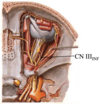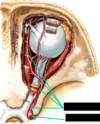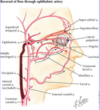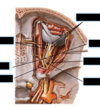Part 3: Nerves of the Eye and Orbit Flashcards
(43 cards)
Draw the ciliary ganglion:

Nerves and arteries entering the orbit that are not contained by the muscles forming the common ring tendon:
FLTS
- Facial Nerve (branch of V1)
- Lacrimal Nerve (branch of V1)
- Trochlear Nerve (CN4)
- Superior Ophthalmic Vein

The common ring tendon surrounds the:
- optic canal
- medial part of superior orbital fissure

What nerves of the trigeminal nerve enter the orbit via the superior orbital fissure?
- branches of the opthalmic nerve (V1)
- frontal nerve
- nasociliary nerve
- lacrimal nerve
Branches of the frontal nerve and their function:
- Trigeminal
- Ophthalmic (V1)
- Frontal
- Supraorbital
- Supratrochlear
SENSORY TO SKIN OVER ORBIT AND FOREHEAD
Branches of the nasociliary nerve:
- Trigeminal
- Ophthalmic (V1)
- Nasociliary
- Long ciliary
- Short ciliary
- Ethmoidal
- Infratrochlear
Lacrimal nerve derivation and function:
- Trigeminal
- Ophthalmic (V1)
- Lacrimal
sensory innervation to lacrimal gland.
postganglionic parasympathetic fibers reach lacrimal gland by hitchhiking on lacrimal nerve.
Postganglionic parasympathetic fibers reach lacrimal gland by hitchhiking on what nerve?
lacrimal nerve
The eyeball receives general sensory innervation from what nerves?
- long ciliary and short ciliary nerves
- both branches of nasociliary
Function of the ethmoidal nerves and their derivation:
- sensory to ethmoid air cells, anterior cranial fossa and nasal cavity
- branches of nasociliary
Label all:


Label all:


The Nasociliary Nerve gives rise to what ganglion?
Sensory Root of the Ciliary Ganglion
Branches of Maxillary Division (V2) of the Trigeminal nerve:
- zygomatic nerve
- infraorbital nerve
Prior to entering the orbit, oculomotor nerve (CN3) divides into:
- Superior Division
- Inferior Division
The superior division of the oculomotor nerve (CN3) carries somatic motor innervation to what muscles?
- levator palpebrae superioris
- superior rectus
The inferior division of the oculomotor nerve (CN3) carries somatic motor innervation to what muscles?
- inferior rectus
- medial rectus
- inferior oblique
What nerve fibers carry preganglionic parasympathetic nerve fibers to the ciliary ganglion?
- inferior division of the oculomotor nerve (CN3)
Trochlear nerve (CN4) innervates what muscle?
superior oblique
Abducens nerve (CN6) innervates what muscle?
lateral rectus
What is the sole blood supply to the visual receptor cells of the retina?
central artery of the retina
Label all:


Draw the Frontal Section Through Orbit Behind Eyeball (layers):

Label all:



















